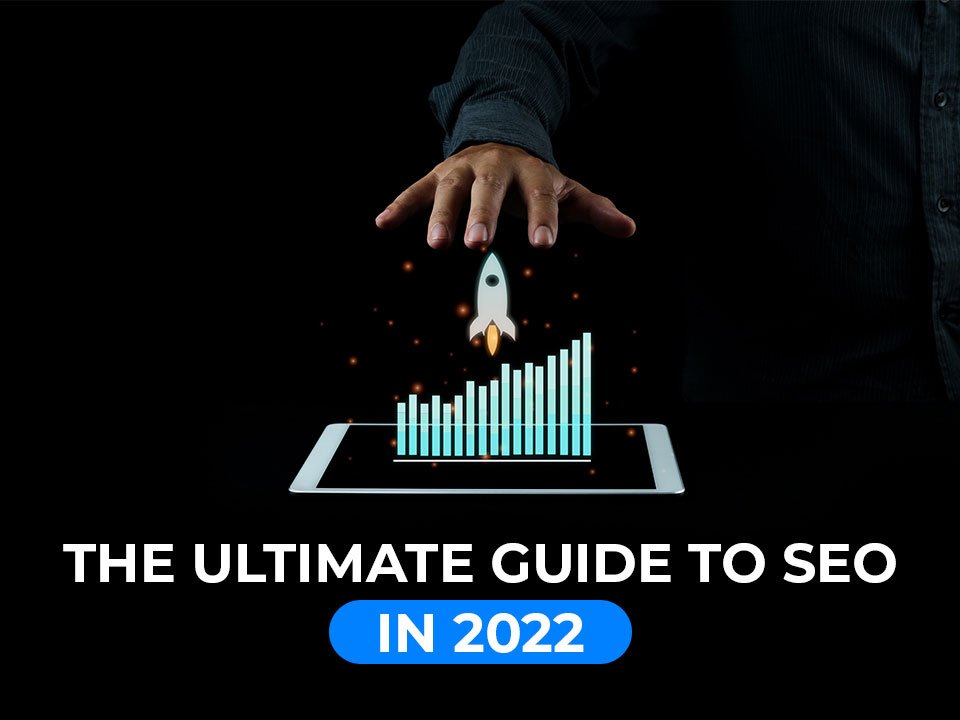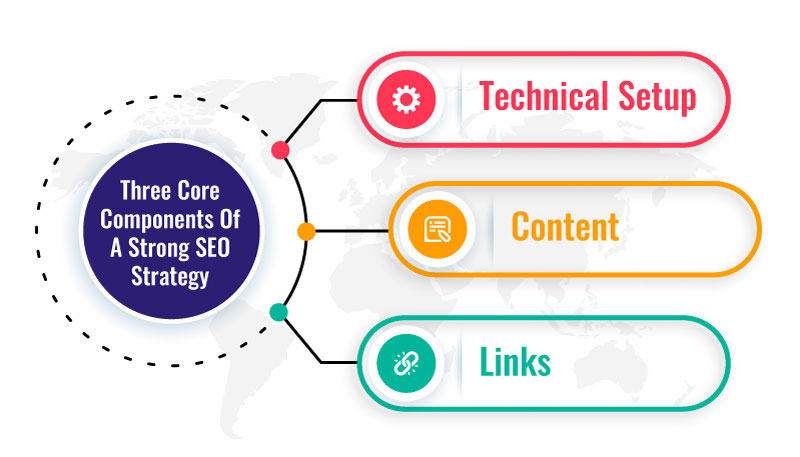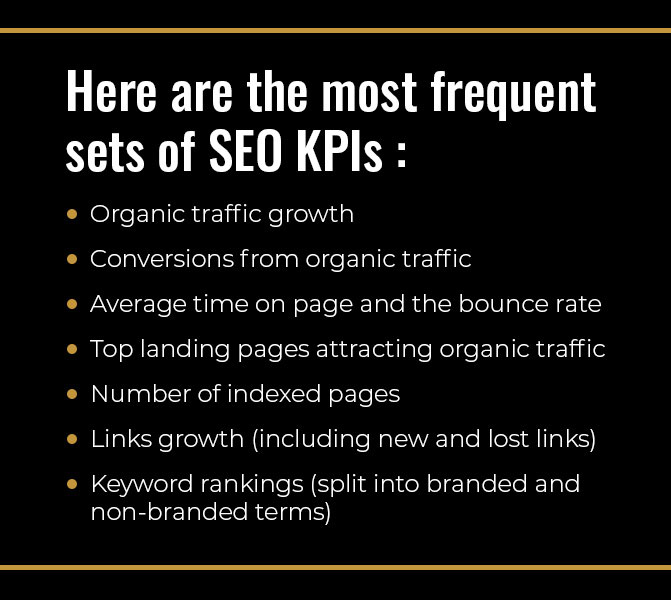
The Ultimate Guide To SEO In 2022
In the era of digital marketing, SEO is a potent weapon. The number of searches and information on the internet has risen dramatically, yet SEO techniques are not keeping pace. We are entering a new period in search engine development. In 2022, we will see a shift in search engines that are more intelligent than ever before. These engines will be able to index changes across web pages, social media posts, and other sources with lightning speed in this new era. This implies that future-oriented search engines may consider relevance to what’s current rather than simply what occurred when they were created or last updated.
In 2022, you’ll need an SEO plan that accounts for how swiftly algorithms change and prepares for the future! Marketers are always hurrying to keep up with current events in their field because of new technologies and shifting trends. In this book, we’ll go through how SEO will develop over the next decade. There’s no doubt that any marketer looking towards the future should be aware of these changes, from Google’s algorithm upgrades to user behavioral changes.
What Is SEO?
The acronym SEO stands for Search Engine Optimization. The objective of SEO is to improve a company’s visibility in organic search results. Consequently, these efforts result in more significant web traffic to the firm’s website, allowing them to generate more conversions and hence more customers and income. We frequently describe SEO as a method for assuring that when someone searches for your product or service category online, they will find your website.
However, this makes the job a little easier. There are a plethora of strategies to boost the SEO of your site pages. The title tags, keywords, image tags, internal link structure, and inbound links (also known as backlinks) are all factors that search engines look for. Search engines also examine site structure and design, visitor behavior, and other external, off-site elements to decide how high your site should be ranked in its SERPs. Rankings and visibility are the primary drivers of SEO.
How Does SEO Work?
SEO takes advantage of a website’s existing content, keyword research, and inbound links to boost the page’s ranking and visibility. While there may be observable changes on the SERP once a search engine has crawled and indexed a webpage, SEO efforts might take months to materialize fully.
Rankings
Search engines use this to determine where your page should rank in the SERPs. Rankings begin at position zero and proceed through the last number of search engine results for a query before settling on one particular place. A web page’s ranking might alter due to aging, competition in the SERP, or algorithmic modifications by the search engine over time.
Visibility
The term “search engine visibility” refers to how well-known a given domain is in search engine results. When a domain isn’t visible for many relevant searches, it has lower search exposure, but the opposite is true when it’s obvious.
Read More: 7 SAMPLE AND FREE SEO TOOL (UPDATED FOR 2022)
What’s The Importance Of SEO?
One of the most crucial reasons to employ SEO is that it assists you in establishing your brand throughout the complete buying process. As a result, SEO can guarantee that your marketing efforts are in sync with current purchasing trends. Because, as Google acknowledged, consumer behavior has irrevocably altered. As of June 2021, 92 percent of internet searches are on a Google property. They also prefer to finish most of the purchasing process independently. According to Statista, 60% of consumers conduct research on a company before making a purchase. Furthermore, this procedure has never been more challenging.
Finally, in the 2022 Buyer’s Survey by DemandGen, 67 percent of B2B purchasers begin their purchase process with a broad web search. How, then, do they use search engines while searching for answers? They start by using Google to discover information about their issue early on. They also inquire about potential remedies. Customers then evaluate their alternatives based on internet buzz or reviews before contacting a firm. However, this happens after they’ve exhausted all means of information gathering. As a result, the only way for customers to notice and consider you is if you appear in their search results.
How Does Google Know How To Rank A Web Page?
Search engines aim to deliver the most relevant answers or information to users. Their algorithms choose pages that are the most relevant to your query every time you use them. And then rank them, putting the most authoritative or popular ones first. To provide users with the best possible information, search engines consider two things:
- Relevancy between the search query and the content on a page. Search engines assess it by various factors like topics or keywords.
- Authority is measured by a website’s popularity on the Internet. Google assumes that the more popular a page or resource is, the more valuable its content is to readers.
Search engines employ advanced equations known as search algorithms to digest all of this data. Search engines keep their algorithms secret. However, over time, SEOs have discovered some aspects they consider when ranking a page. We refer to them as ranking factors, which are the subject of an SEO campaign. Adding more content, optimizing image filenames, or enhancing internal connections can all influence your rankings and search visibility. And that’s because each one of these activities improves a ranking element.
What Is The Definition Of SEO Strategy?
An SEO marketing approach is a comprehensive strategy to increase traffic to your website using search engines. On-page and off-page tactics are elements of successful SEO, which employ intent-based keywords on the surface and inbound links from other websites on the back end.
Three Core Components Of A Strong SEO Strategy
Improving a website’s ranking factors in three areas — technical site setup, content, and links – is essential for optimizing it. So let us take them one by one.
1. Technical Setup
For your website to be ranked well, three things must occur:
- To begin, a search engine must locate your website’s pages.
- Then, it must read them to comprehend their subjects and discover their keywords.
- Finally, it must add them to its index, a database of all the material it has discovered on the internet. As a result, your website may be shown for relevant searches in its algorithm.
It appears to be straightforward, doesn’t it? There’s nothing to be concerned about. After all, you can visit your site without issue, so why not Google? Unfortunately, there is a catch. It’s just text to a search engine. As a result, any elements it cannot render in this manner are hidden from the search engine. And so, despite your website being okay, Google may determine its information unavailable.
The most significant variables affecting it include the following:
Website Navigation And Links
Search engines crawl websites just as you would. They follow links. Search engine crawlers scan a website and use links to locate additional information for analysis. However, they cannot view images, as we’ve previously stated. As a result, make the navigation and connections text-only.
Simple URL Structure
Search engines don’t like reading lengthy strings of words with complex structures, so keep your URLs as short as possible. If at all possible, keep your URLs brief. Make sure they include as little extra information as possible beyond the primary keyword for which you want to optimize the page.
Page Speed
The load time — the amount of time it takes for a user to be able to read a website page — is used by search engines as an indicator of quality. A variety of things influence it. For example, picture dimensions. Use Google’s Page Speed Insights Tool to get recommendations on how to make your sites faster.
Dead Links Or Broken Redirects
A dead link sends someone to a non-existent page. A broken redirect takes someone to a resource that may no longer be accessible. Both have negative user experiences, but they prevent search engines from indexing your material.
Sitemap And Robots.txt Files
A sitemap is a small file that lists all of your site’s URLs. Search engines use it to determine which pages to crawl and index. A robots.txt file, on the other hand, specifies what material should not be indexed (For example, policy pages you don’t want to appear in search.) To improve the crawling and indexing of your content, create both.
Duplicate Content
The same material confuses search engines, especially when it’s the same content. It’s nearly impossible for them to display any of those pages. Your website may be penalized if search engines discover them. As a result, search engines consider duplicate content a negative point.
2. Content
Whenever you use a search engine, you seek information on a particular subject or problem. True, this content may come in many different forms. It might be text like a blog article or a web page. But it could also be audio, product suggestions, and company listings. Everything is considered content. And it’s what promotes higher search visibility.
Here are two reasons why:
- Customers want content when they search for it. It’s the stuff that provides whatever they’re searching for. Furthermore, the more you offer, the more likely you will receive increased search traffic.
- Search engines use content to figure out how to rank a page. Earlier, we discussed the relevance between a page and a person’s search query.
They evaluate a page’s topic as they crawl it. They use page length and arrangement to determine how good a site is. Search algorithms based on this data may link a person’s query with the most relevant pages.
Keyword research is the first step in optimizing content.
Keyword Research
Getting any traffic to your site is not the goal of SEO. You want to attract people who are interested in what you have to offer and can become leads, as well as customers. However, this is possible if it ranks for the right keywords in search engines. Otherwise, there’s no chance they’ll discover you. (Unless your website appears at the top of search results.) As a result, SEO efforts begin by identifying which terms potential consumers enter into search engines.
The first stage in the process is to determine keywords and subjects that are relevant to your company. Then convert them into initial keywords. Finally, perform extensive research to discover your audience’s related terms. We’ve put up a comprehensive guide to keyword research for beginners. It explains how to go about doing keyword research. Identify search phrases you should be targeting using it.
With a list of keywords, the next step is optimizing your content. On-page SEO is the term used by SEOs to describe this procedure.
On-Page Optimization
On-page optimization, also known as on-page SEO, ensures that search engines understand a page’s topic and keywords and can match it to relevant searches. Note that I said “page” rather than “content.” It’s because although the focus of on-page SEO efforts is on the words you use, it also includes code optimization. You’ve probably heard about some of them – meta tags like title and description are two of the most common. There are others, though.
So here’s a rundown of the essential on-page SEO steps to take.
(a) Keyword Optimization
To begin with, make sure Google understands the keywords you want your site to rank for. To do so, make sure you include at least the primary keyword in the following:
- Post’s Title: Leave a few spaces before the period, and then place the period on its line. Ideally, it should be placed near the beginning of the title. Google is notorious for putting more significance on words at the start of a headline.
- URL: Yes, Google has specific URL limits based on the keyword. The keyword should not only be included in the page’s URL but also in the page’s content. Remove any stop words from your page’s text as well.
- H1 Tag: This tag displays the page’s title in most content management systems. However, double-check that your platform does not have a different option enabled.
- The First 100 Words (Or The First Paragraph) Of Content: It’s good to start your blog post with a keyword to reassure Google that this is, in fact, the focus of the page.
- Meta-Title And Meta-Description Tags: These two HTML code components are used by search engines to display their advertisements. The meta-title is used as the title of the search listing, while the meta-description provides information for the snippet below it. But they also use both to delve deeper into the page’s subject.
- Image file Names And ALT tags: Consider how search engines see pictures on a page. They can only see the file names of the graphics on the page. As a result, at least one of the photographs should contain the term in the file name.
(b) Non-Keyword-Related On-Page Optimization Factors
On-page SEO is not only about sprinkling keywords throughout the document. The following variables also contribute to a page’s trustworthiness and authority:
- External Links: Linking out to other relevant sites on the theme aids Google in determining the topic further. It also gives a pleasant user experience by putting your material in a position of a valuable source of information.
- Internal Links: The following are some examples of external links that may help you improve your search engine results. The first helps link to other pages on the site so that search engines can find and crawl them. The second is vital because it tells how one page relates to another, which can assist in determining the blog’s relevance to the query. Internal connections should be present at least twice as many as external links per blog post.
- Content’s Length: Longer content usually ranks higher. That’s because, if done correctly, a longer blog post will always contain more thorough information on the subject, allowing visitors to stay on your site longer. That’s known as dwell time and an important ranking factor for search engines.
- Multimedia: Although not required, multimedia components such as videos, flowcharts, and audio players may communicate the quality of a page. It keeps visitors on a page for longer, much like more extensive content. In addition, it indicates that they believe the material to be valuable and worth pursuing.
3. Links
Links make a page popular. Backlinks are references to your material on other websites. You get a backlink to your website every time another site draws attention and directs visitors to your work.
Some — low-quality ones — may have a detrimental influence on your rankings.
Links Quality Factors
Links with low quality or questionable origins, such as those that Google might consider deliberate attempts to make it believe a site is more authoritative, can harm your rankings. That’s why when it comes to obtaining links, SEOs focus on building the best ones they can when it comes to getting links.
Naturally, like any other search algorithm, we are unaware of what influences a link’s quality. SEO, on the other hand, has identified a handful of factors that influence link quality:
- The Popularity Of A Linking Site: A high-quality link from a domain that search engines recognize as an authority will undoubtedly be present. For example, links from websites with good quality backlinks will provide better results.
- Topic Relevance: The authority of a website, for example, Amazon.co.uk, is higher than that of a website on an unrelated subject like Google (you could use your site as the basis for comparison).
- Trust In A Domain: Search engines likewise consider a website’s trust when ranking it. Links from more reputable sites will always impact rankings.
Link Building
In SEO, link building is the process of gaining new backlinks. And many practitioners agree that it might be an exhausting job. Creating a link-building strategy to produce high-quality links takes creativity, strategic thinking, and perseverance. To build strong connections, you must come up with a plan.
Here are some strategies to do it:
- Editorial, Organic Links: These backlinks are from websites that include your material in some way.
- Outreach: In this method, you contact other websites for links. This may be achieved in a variety of ways. You might create fantastic work and send it to them to inform them about it. They’ll subsequently include a link to it if they find it valuable. You can also advise them on where they could link to your material.
- Guest Posting: Blog articles that you post on third-party websites are known as guest contributions. As a result, those businesses frequently allow text and author biographies to include one or two links to your site.
- Profile Links: Finally, many websites provide a means to establish a connection. An excellent example is an online profile. When creating such a profile, you may also include your website. Not all of these links are extremely powerful, but some are. And because they’re so simple to produce, they’re worth pursuing.
- Competitive Analysis: Finally, many SEOs audit their competitors’ backlinks to see if they can replicate any for their sites.
If you’ve made it this far, you’ve probably discovered what’s causing your site’s success in search. The next step is to determine whether your efforts are practical.
How to Monitor & Track SEO Results
Monitoring the success of your SEO efforts entails measuring data such as traffic, interaction, and links. And while most organizations develop their own sets of SEO KPIs (key performance indicators), the following are the most frequent:
Local SEO
We’ve been talking about improving your site’s ranking in search results. If you own a local company, Google also allows you to target potential consumers in your region specifically. However, for this, you’ll need local SEO. It’s truly worth it. Local businesses get 64.42 percent of Google searches. They’re seeking vendor suggestions and even specific company addresses. Furthermore, they utilize this knowledge: 74% of searchers visit a local store or company’s premises within 24 hours of searching.
But wait, isn’t local SEO the same as what we’ve been discussing all along? Yes and no. Search engines employ similar algorithms for both local and worldwide rankings. However, given that they want to place a site to deliver location-specific results, they must consider additional ranking criteria.
Even local search results look different:
- They appear only for searches with a local intent (for example, “restaurant near me” or when a person clearly defined the location.)
- They contain results specific to a suitable location.
- They concentrate on delivering specific information to users that they don’t need to go anywhere else to find.
- They target smartphone users primarily as local searches occur more often on mobile devices.
Black Hat SEO?
The final component of SEO we’d like to discuss with you is something I hope you’ll never be tempted to use. I mean it. Because while it may seem appealing at first, employing black hat SEO usually results in a search ranking penalty.
Black hat techniques are used to manipulate search engine algorithms. The most frequent black hat methods include keyword stuffing, cloaking (hiding keywords in code so that consumers don’t see them, but search engines do), and purchasing links. So, why would someone use black hat SEO? One reason is that ranking a website according to Google’s standards can take time. Longer than most people would think. For a long time, in fact. Like black hat approaches, red hat tactics can help you simplify the complexity of link building. Keyword stuffing allows users to rank one page for many keywords without creating more content.
Should You Outsource SEO Or Keep It In-House?
Whether you do it yourself, delegate it to someone on your team, or outsource it entirely, you’ll want to be as knowledgeable as possible when making this decision.
Doing SEO Yourself
Are you interested in SEO? Do you have the time to get started? Do you have the resources to hire experts if your website is redesigned and inadvertently deindexes several pages? If any of these answers are “no,” you might not want to take on the responsibility of SEO yourself. Long-term SEO success necessitates work regularly. Just like a muscle, you need to exercise it daily to see results. That might be difficult. If you have any reservations, consider delegating the task instead.
Delegate SEO To A Team Member
If you’re unsure whether or how to implement SEO on your own, consider outsourcing the job to a coworker. This will be a valuable skill to develop their career if you have someone passionate about growth marketing, development, or even web design on your team. You might hire a full-time search engine optimization expert if you have the finances.
This person can report to the marketing team, development team, or even the design team. Because SEO involves nearly every aspect of a business while requiring a distinct set of talents, this job will not be subject to frequent changes if departments need to be reorganized later. Because this position requires cross-functional contributions more often than not, you’ll have some control over how you manage them.
Outsource SEO To An Agency
You don’t have the time, interest, or money to hire a full-time SEO specialist. What do you do now? Outsourcing SEO to a reputable consultant is the best way to get the most bang for your buck. Why? First, well-known SEO consultants are highly skilled in generating organic traffic, leads, and conversions for businesses. They do this daily, so they won’t require as much time to learn the fundamentals as you or a team member. Second, a consultant may be less expensive than employing someone full-time for the job since they don’t need health insurance or payroll taxes.
The Bottom Line
Your company may survive without a soufflé, but SEO is not something that you can do without. It’s your primary source of visitors and the most exemplary method to outperform your rivals.
To put SEO into action, your website must:
- Make sure that your site offers an excellent experience to your visitors
- All your contact details should be easy to find
- Your products need to be organized
- The content on your site should be updated, valuable and relevant to your target audience.
- Quickly fix any SEO errors as soon as they come up.
You may undoubtedly do your SEO if you spend some time each week on your site. Suppose you’re unsure whether it’s better to hire a freelancer or an Agency to handle it for you. Book a FREE call with our experts for your complete SEO setup.




